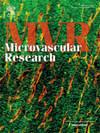新的2D/3D血管生物标志物揭示眼底变化与冠心病之间的关联
IF 2.7
4区 医学
Q2 PERIPHERAL VASCULAR DISEASE
引用次数: 0
摘要
目的利用光学相干断层扫描(OCT)/OCT血管造影(OCTA)技术比较冠心病(冠心病)患者与非冠心病患者视网膜黄斑区结构和血管的差异。方法采用180例冠心病患者340只眼和68例对照组136只眼。成像采用以黄斑为中心的6mm * 6mm视场的AngioVue OCT装置。视网膜厚度和2D/3D血管相关生物标志物使用现有的视网膜层分割软件,以及我们之前提出的2D/3D血管和3D中央凹无血管区分割方法。统计分析包括t检验、Mann-Whitney U检验、卡方检验和Pearson相关检验。结果冠心病组视网膜神经纤维层(RNFL)厚度显著降低(r = - 0.20, P <;0.001),基于黄斑区域层分割。在3D OCT图像中,根据ETDRS网格的定义,冠心病组外上(out-S)区视网膜内外层均明显变薄。冠心病组总体二维分形维数(FD)显著低于冠心病组(1.72±0.03 vs. 1.73±0.02,P <;0.001)和血管骨架密度(VSD)(26.61±4.52∶28.50±3.40,P <;0.001),与对照组相比。三维血管密度(VD)特征组间差异有统计学意义(19.23±5.67 vs. 20.69±5.15,P = 0.048)。结论视网膜厚度变薄和血管密度降低与冠心病相关,可作为评估冠状动脉疾病的有价值、有成本效益的生物标志物。本文章由计算机程序翻译,如有差异,请以英文原文为准。
Novel 2D/3D vascular biomarkers reveal association between fundus changes and coronary heart disease
Purpose
To compare structural and vascular differences in the macular region of the retina using optical coherence tomography (OCT)/OCT angiography (OCTA) between coronary angiography (CAG)-confirmed coronary heart disease (CHD) patients and non-CHD individuals.
Methods
The study included 340 eyes from 180 CHD patients and 136 eyes from 68 controls. Imaging was conducted using the AngioVue OCT device with a macula-centered 6 mm ∗ 6 mm field of view. Retinal thickness and 2D/3D vascular-related biomarkers were derived using existing retinal layer segmentation software, and our previously proposed 2D/3D vascular and 3D foveal avascular zone segmentation methods. Statistical analyses included t-tests, Mann-Whitney U tests, chi-square tests, and Pearson's correlation.
Results
The CHD group exhibited significantly lower retinal nerve fiber layer (RNFL) thickness (r = −0.20, P < 0.001) in the inner inferior (I) region, based on macular region layer segmentation. For the 3D OCT images, as defined by the ETDRS grid, both the inner and outer retina layers in the outer superior (out-S) region were significantly thinner in the CHD group. The CHD group showed significantly lower overall 2D fractal dimension (FD) (1.72 ± 0.03 vs. 1.73 ± 0.02, P < 0.001) and vessel skeleton density (VSD) (26.61 ± 4.52 vs. 28.50 ± 3.40, P < 0.001) compared to the control group. The proposed 3D vascular density (VD) feature showed a significant difference between the groups (19.23 ± 5.67 vs. 20.69 ± 5.15, P = 0.048).
Conclusion
Thinning of retinal thickness and reduced vascular density are associated with CHD and may serve as valuable, cost-effective biomarkers for assessing coronary artery disease assessment.
求助全文
通过发布文献求助,成功后即可免费获取论文全文。
去求助
来源期刊

Microvascular research
医学-外周血管病
CiteScore
6.00
自引率
3.20%
发文量
158
审稿时长
43 days
期刊介绍:
Microvascular Research is dedicated to the dissemination of fundamental information related to the microvascular field. Full-length articles presenting the results of original research and brief communications are featured.
Research Areas include:
• Angiogenesis
• Biochemistry
• Bioengineering
• Biomathematics
• Biophysics
• Cancer
• Circulatory homeostasis
• Comparative physiology
• Drug delivery
• Neuropharmacology
• Microvascular pathology
• Rheology
• Tissue Engineering.
 求助内容:
求助内容: 应助结果提醒方式:
应助结果提醒方式:


